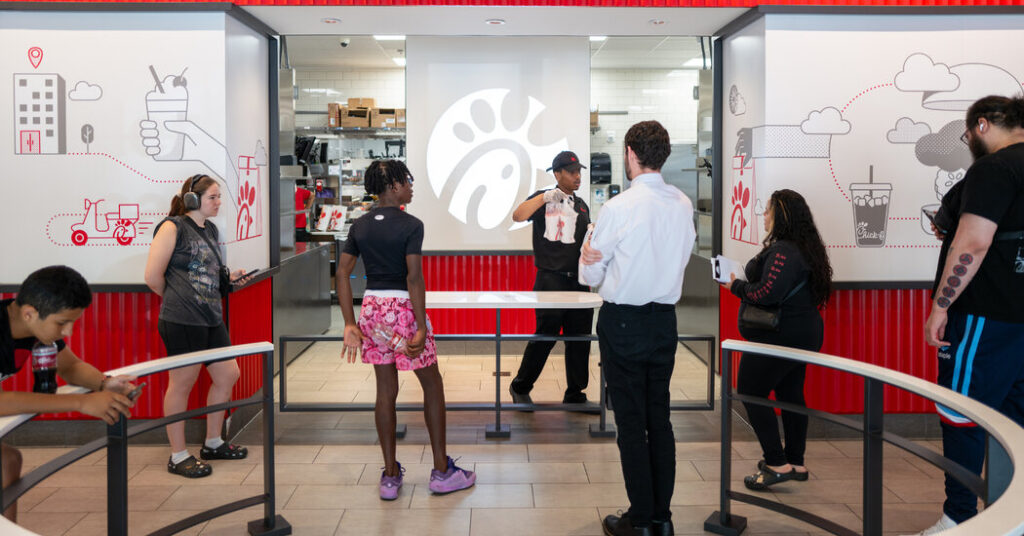New York City's new Chick-fil-A location has everything you'd expect from a chicken joint: friendly staff, crispy waffle fries, and a line of hungry diners. But there's one thing it's missing: seating.
The Upper East Side location, which opened in March, is the chain's first to focus exclusively on takeout and delivery orders, part of a trend of smaller, take-out-focused locations that has boomed during the pandemic and remains popular among coffee shops and fast-food chains, particularly in Manhattan.
Between 2019 and 2023, the average retail lease size in Manhattan is expected to shrink 17%, to 2,585 square feet, according to commercial real estate data firm CoStar Group.
Gregory Zamfotis, founder and CEO of Gregory's Coffee, said the decline is most noticeable in coffee shops, where Manhattan residents have fewer places to sit.
“In many places, people have fewer options for where to stay because other businesses have switched over or pivoted and reduced their seating capacity,” Zamfotis said.
It's hard to gauge exactly how much cafes and fast-food joints have downsized — many commercial real estate brokerages, including CBRE and Cushman & Wakefield, track only a handful of the small leases these tenants sign each year — but real estate analysts, brokers and tenants all agree that retailers are downsizing.
“Smaller is better,” says Steven A. Soutendyk, a managing director at Cushman & Wakefield. “There are a lot more tenants looking for smaller stores than there are tenants looking for larger stores.”
One person considering smaller stores is Benjamin Solmonte, co-founder and CEO of cafe and bakery chain Maman, which plans to open a smaller version of the chain (dubbed Petite Maman) after its first location opens at Moynihan Train Hall in 2022.
Petite Maman locations will range from 350 square feet to 800 square feet, while full-service Maman locations will be as large as 3,200 square feet, Solmonte said. Smaller stores allow the company to target customers on the go and give it more flexibility when locating new locations — a crucial advantage given Manhattan's historically low number of retail stores.
Buffalo Wild Wings, Starbucks, Blank Street Coffee, and Whole Foods have also announced or rolled out small, take-out-focused locations in New York City in addition to their existing locations. Blank Street, in particular, was born out of a smaller-format store model, with most locations smaller than 350 square feet to allow for quicker service to customers.
“Any retailer trying this has adopted both models,” says David Firestein, managing partner at brokerage SCG Retail. “Brands with 10, 20, 50, 100 stores are constantly looking at their model, constantly changing and evaluating. That's what great retailers do.”
Chick-fil-A is getting the best of both worlds on the Upper East Side: It opened a new mobile pickup location on Second Avenue and East 80th Street just steps away from a brick-and-mortar sit-down location on Third Avenue and East 86th Street. Jared Caldwell, owner and operator of both locations, said he wanted the design of the new location to complement the first and help it keep up with growing numbers of digital orders.
Another big advantage of small stores compared to regular-sized stores is that rent is cheaper.
For example, Gregory's Coffee stores in Manhattan range in size from 400 square feet to 1,800 square feet and ask for rent of $100 to $300 per square foot, Mr. Zamfotis said. Within that range, the cheapest 1,800-square-foot store will cost $60,000 more per year than the most expensive 400-square-foot store.
“It can be hard to justify paying for 300, 400, 500 extra square feet of space for seating that you don't necessarily need,” Zamfotis says. “You don't need a ton of seating, just enough to support some of the guests who want to stay.”
For cafes, smaller stores mean a departure from the “third place” business model popularized by Starbucks, a space that acts as a departure from work or home, a place where people can stay for hours, connecting with friends and making new ones.
“A third place can be anywhere people congregate — a local bar, a public park, a fast-food restaurant like McDonald's,” says Cathy Giuffre, professor emeritus of sociology at the University of Colorado. Places where quick service, short hours, or space constraints limit social opportunities can increase feelings of loneliness and isolation.
“Any place where you can get in and get out quickly has great benefits,” she says. “The social costs are less visible, but they're very real.”
But Zamfotis doesn't believe small stores will signal the end of coffee shops as a third place, given Manhattan's limited space and high rents.
“I'm a firm believer in the future of third places,” he says. They might look different, but they'll still be there, because people still want places to gather. And coffee has always been a central place for people to gather,” he points out.



